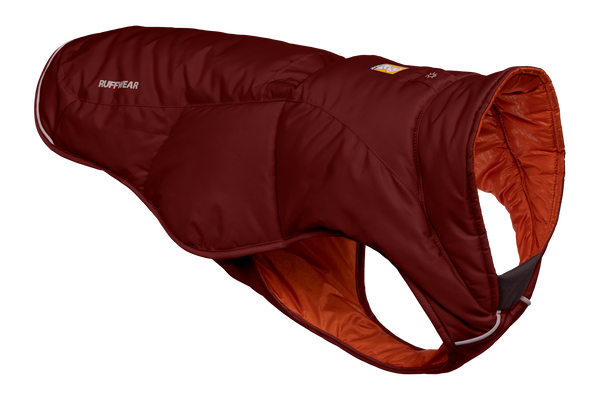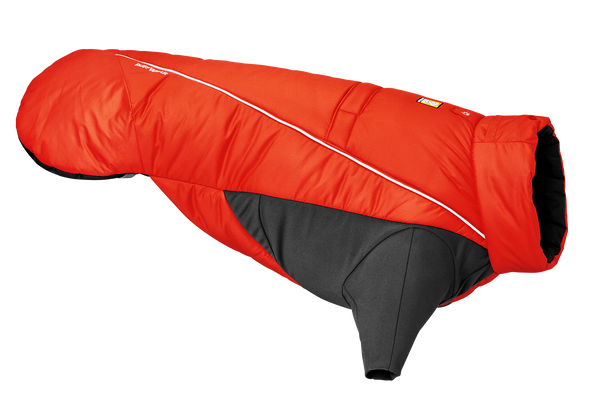Tips for Cold Weather Adventures and First Aid for Dogs
There is nothing quite like watching your best friend bounding (or snorkeling) through fresh snow beside you, or the thrill of being pulled along on Nordic skis by a happy hound. But a winter spent outdoors with your dog comes with its own set of challenges – short hours of daylight, cold temperatures, wet weather, and sharp ski edges can rapidly cut your adventure short. Below are a few safety considerations for powder hounds, so that you can have a howling good time without having to end the day at the veterinary clinic!

Photos Contributed by Ruffwear Ambassador, Dr. Bronwyn Fullagar
First, consider your dog’s cold tolerance. Have you noticed that not all dogs are created equal when it comes to their fur coat? While arctic breeds (huskies, malamutes), and their wild ancestors (wolves, coyotes) are wearing the equivalent of a high end layering system, other breeds are wearing a t-shirt! Very young or very old dogs will feel the cold more than healthy adults, and very small dogs tend to get colder more quickly than larger ones. It’s a good idea to do some test adventures outside in early winter with your dog – short activities like running or cross country skiing where there is the option of turning around early or going inside to warm up – to get an idea of how long your dog can comfortably spend exercising outside in different temperatures.
Hypothermia
This is a potentially life-threatening condition where a dog’s core body temperature drops below 35oC (95oF). Dogs who are outside for prolonged periods, who are tired, hungry, or standing still, particularly in wet or windy weather, are most at risk.
Signs to look for: Strong shivering followed by no shivering, acting sleepy or lethargic and weak, fur and skin that are cold to the touch. In advanced cases, dogs develop decreased heart rate, pale gums, trouble walking and eventually unconsciousness.
How to treat: Remove your dog from the cold environment and place in a warm room. Dry your dog thoroughly using towels or a hair dryer set on low. Wrap your dog in a warm blanket and surround him with warm hot-water bottles wrapped in towels. Be careful not to place warm objects directly in contact with your dog’s skin. Allow your dog to drink warm (not hot) fluids. Check your dog’s rectal temperature with a thermometer. If it’s below 35oC or if your dog seems lethargic or is unresponsive, take him to a veterinarian immediately for evaluation.
Prevention strategies: Keep your dog warm in the snow by using an insulated dog coat that covers her chest. Bring an extra coat in your bag in case of a change in weather or an unexpected delay. Take breaks sheltered from the wind and snow and place a mat on the snow for your dog to lie on. Pack high-energy snacks and water for your dog on adventures longer than 1 hour. Monitor your dog while outside for shivering and consider finishing your adventure early or seeking shelter if your dog is cold.
Frostbite
In cold temperatures (<0oC or 32oF), both humans’ and dogs’ bodies reduce blood flow to their extremities, to preserve heat near the vital organs of the core. Long periods of reduced or absent blood flow can cause serious injury and even death of these regions. Dogs’ ears, noses, tail tip, and prepuce are most at risk. But why don’t all dogs develop frostbite in their feet from running in the snow barefoot? The answer lies in the unique circulation (blood flow) system of dogs’ paws, which it turns out is still very similar to those of wolves and arctic foxes.
Firstly, a unique configuration of blood vessels called the countercurrent exchange mechanism allows cool venous blood returning from the paws to the heart to be warmed by incoming, arterial blood. This maintains the dog’s core body temperature, even when the feet are standing in freezing snow. Secondly, a special network of blood vessels near the surface of the pads actually dilates when the surface temperature of the feet drops below 0oC (32oF), which allows a small amount of warm blood to periodically flow to the pad surfaces. The result: a warm core and cool (but not freezing) feet!
Signs to look for: Pale, grey or bluish discoloration of the skin of the extremities, coldness or brittleness of the area when touched, pain and swelling as the areas warm up, blisters or skin ulcers, blackened or dead skin (days after cold exposure).
How to treat: If you suspect your dog has suffered frostbite, seek veterinary attention immediately. Treat for hypothermia (see above). You can gently try to warm the frostbitten skin in your hands, but rewarming must be performed slowly to prevent further damage. Prevent your dog from self-traumatizing frostbitten areas. Avoid the temptation to administer human pain relief medications, these are generally not safe for dogs and can worsen the situation.
Prevention strategies: Maintain and monitor your dog’s core body temperature by using a dog coat like the Furness™ Dog Jacket or Powder Hound™ Dog Jacket and the advice above for preventing hypothermia. Avoid prolonged exposure to very cold temperatures, especially in windy weather and for short-coated dogs.

Foot injuries and lacerations
One of the most common injuries seen in dogs that venture into the backcountry in winter is lacerations from sharp ski edges. Dogs’ feet can also develop abrasions from rough snow and ice, irritation from sand and salt used on roads, cuts to the paw pads and torn nails. What seems like a minor injury can become much more serious if it delays your return to the car during winter in the backcountry. Having a small first aid kit (see below) for your dog can be very useful in these situations.
Signs to look for: Limping or lameness is the most common sign of foot and lower limb injuries. Sometimes a small laceration will not cause lameness but you may notice blood on the snow. If your dog is limping, have a friend hold her and carefully inspect her lower limb(s) and feet. Clear snow from between the paw pads and inspect the nails. If there is no external wound or torn nail and no snow between the toes, a soft tissue (tendon or ligament) injury is possible.
How to treat: For injuries or irritation of the paws, pads or nails, clear snow from between the toes, dry the foot if possible and place a dog boot on the injured paw. If your dog still seems reluctant to walk on the limb, consider returning to the trailhead. For lacerations further up the limbs, place a sterile dressing (plain gauze is fine) and wrap the region with ‘Vetrap’ (see first aid kit). Be aware that this bandage is temporary and should only be left on for a maximum of 2 hours. Seek veterinary attention as soon as you get home.
How to prevent: The best way to avoid ski edge lacerations is to train your dog to run downhill behind the group a safe distance from skis. If running on pathways that have been sanded or salted, dog boots are a great way to prevent irritation to the paw pads. Likewise, boots like the Polar Trex™ Dog Boots help to keep snow and ice from building up between the toes. Keeping the hair between the toes short and applying Vaseline or a commercial dog foot salve (used by mushers) before going out for the day can also help to repel snow.

Having an exit plan
Lastly, consider the worst case scenario for your dog – he is injured and cannot walk back to the trailhead. What is your exit strategy? Are you or someone in your group able to carry your dog out? Training your larger dog to be carried over your shoulders could prove very helpful. For small and medium dogs, having a well-fitting harness with a wide chest panel and handle can make carrying much easier. A harness is also great if your dog gets stuck in deep snow or needs help getting out of a precarious position!
Hope you found this information helpful, feel free to ask questions or comment below. May your winter be happy, safe and full of smiles and wagging tails!

Essential gear and first aid kit for powder hounds
Coat (plus a spare for longer adventures)
Water
High-energy dog snacks
Splint (aluminum or plastic, usually found in human first aid kits)
‘Vetrap’ bandage (colored, self-adhesive, conforming bandage available at vet clinics)
Sterile dressing or gauze to place over a wound
Vaseline or dog foot salve
Bandage or cravat for muzzling (any dog that’s in pain can bite)
__
Dr. Bronwyn Fullagar is a specialist veterinary surgeon based in Canmore, Alberta. When not in the clinic, she can be found exploring the backcountry of the Canadian Rockies on skis or on foot with her enthusiastic mountain hound, Arnie. You can follow her veterinary adventures @drbronfullagar.


















